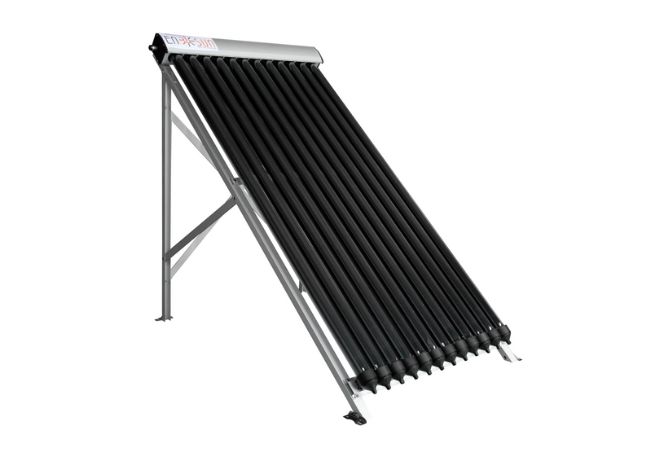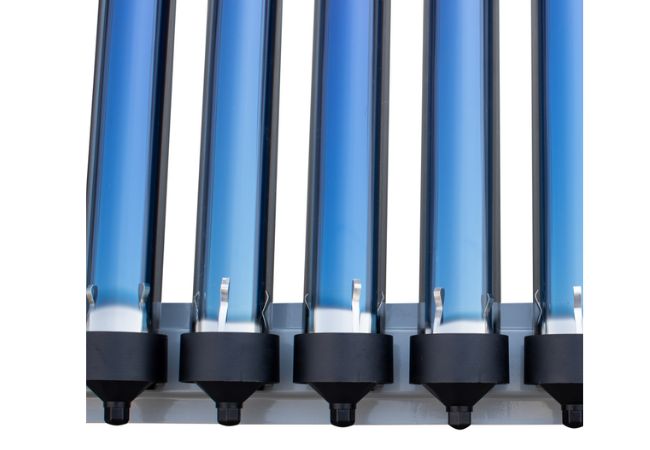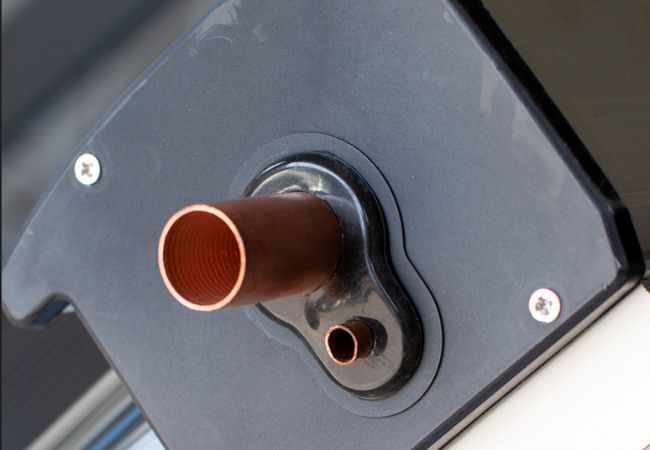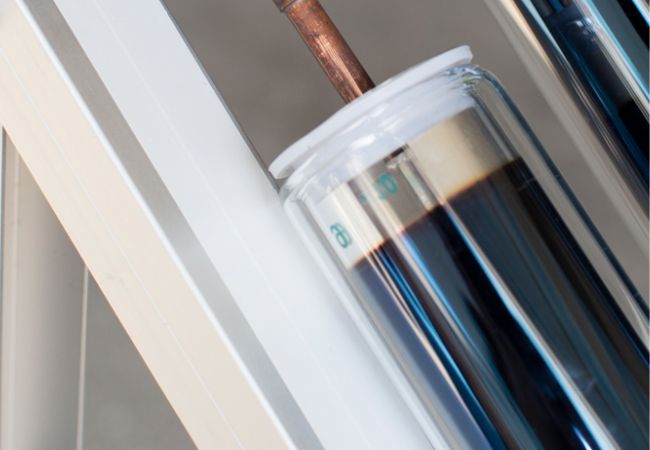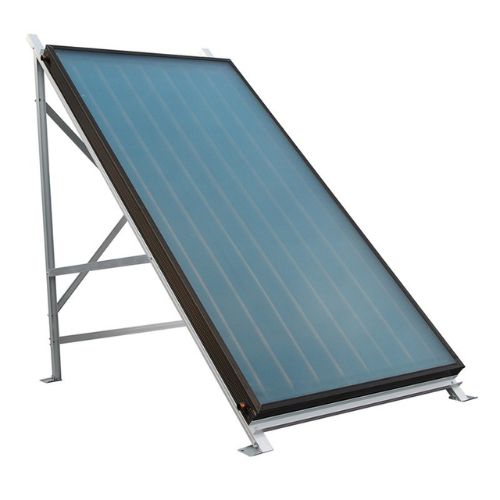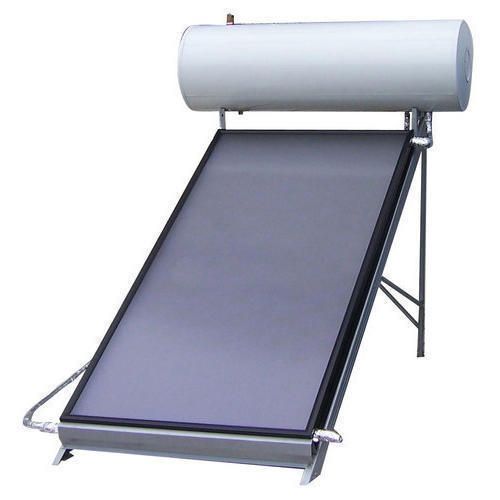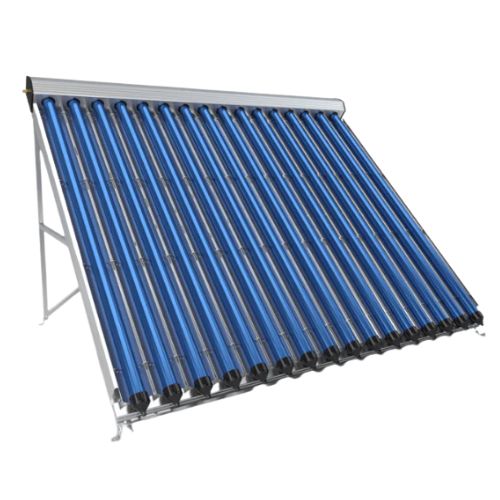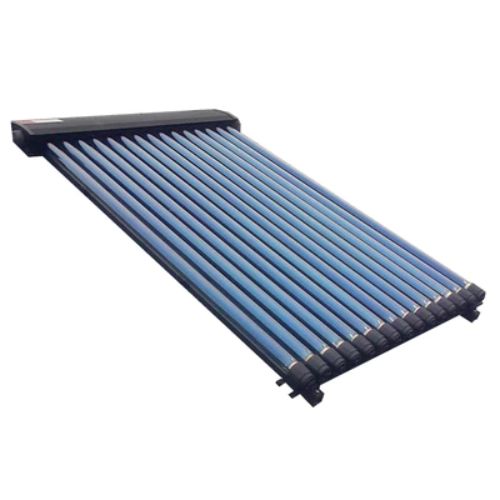Ensun - Heat Pipe Solar Collector
ENSUN high efficient heat pipe solar heat collector is a good solution for your client’s room heating project, swimming pool heating project and home hot water. You will receive high quality solar heat collector with us and reliable after-sales service. If you have a plumber, you can install the solar collector easy.
- EN12975 Solar Keymark certified products
- Ideal solution for home hot water, room heating and swimming pool heating
- Reliable & high efficient tri-element evacuated vacuum tubes
- Copper heat pipes for rapid heat transfer
- Manifold pipeline is made of all copper which is high efficient in heat transfer
- Corrosion resistant material for all kind of climate
- Easy plug-in installation
- Comprehensive life time more than 15years
Your Trusted Heat Pipe Solar Collector Manufacturer
We assure you that our solar collectors can provide you with high performance and long life of service. All of this has passed international standards such as SOLAR KEY MARK, ISO 9001, TUV, SPF, CE, and RoHS.
We have over 15 years of experience in the production of solar collectors. The heat pipe solar collectors are well exported to Europe for the past 15 years.
The solar collectors are performed well in a cold areas such as Finland, Denmark, North Ireland, Norway, Sweden, and so on the area.
Send us your message now!
Components of Heat Pipe Solar Collectors
Our heat pipe solar collector are consist of the following components such as:
- Evacuated vacuum tubes
- Copper mainfold pipeline
- Copper heat pipe
- Heat transfer fins
- Rockwool mainfold insulations
- Manifold casing
- Mounting frame
- Rubber components and more.

Our heat pipe solar collectors are designed to be used in different field of application especially for:
- Domestic water heating
- Center heating
- Swimming pool heating
- Room heating
Large scale
- Solar Absorption: Solar radiation is absorbed by the evacuated vacuum tubes and converted
into heat. - Solar Heat Transfer: Heat pipes conduct the heat from within the solar tube up the manifold pipeline.
- Solar Energy Storage: Water or water mix is circulated through the manifold pipeline, via intermittent pump cycling. Each time the water circulates through the manifold pipeline the temperatures are raised by 5~10 ℃ /9 ~ 18 ℉. Throughout the day, the water in the storage tank is gradually heated.

Related Product
Heat Pipe Solar Collector -The Ultimate Guide
Choosing a heat pipe solar collector can be a challenging process without the right information. This guide explores some fundamental factors you must know.
What is a Heat Pipe Solar Collector?
Heat pipe solar collector is a special pipe in water heater systems that covers energy from the sun to a thermal energy for heating water.
Advantages of Heat Pipe Solar Collectors
- Durability and longevity: The heat pipes are usually made of tough and durable materials such as aluminum and copper.
- Efficiency: They have a high thermal efficiency as a result of the quick absorption and transfer of heat.
- Wide temperature range: They can effectively operate in a wide range of temperatures thus suitable in applications that require a wide range of temperatures.
- Even distribution of heat: Consists of multiple heat pipes thus increasing the surface area for effective distribution of heat.
- Reduced heat loss: Have a low thermal resistance that enables them to reduce the amount of heat loss.

Heat Pipe Solar Thermal Collector Classification
- Evacuated tube solar collectors – They consist of glass tubes that are well-fitted to surround the absorber to create a vacuum.
- Flat plate solar collectors – They consist of a transparent covering layer that allows the transmission of solar energy as well as an absorber plate with pathways for the circulation of fluid.
- Vacuum tube collectors – They have vacuum tubes that are made of aluminum or copper and silicate materials and are arranged in an array format to maximize the absorption of solar energy.
Heat Pipe Thermal Collector Parts
Heat Pipe
They consist of heat pipes that are covered with aluminum or copper materials. They are significantly important in the transfer of heat mainly from the absorbers to the condensers by the use of the phase change principle.
Absorber Plate
It is a metallic plate that is responsible for the absorption and conversion of solar energy into thermal energy.
Condenser Part
This part is connected to the manifold where heat is collected from various heat pipes. It forms the upper section of the pipes where the transfer of heat to the medium occurs.
Evaporation Chamber
It forms the lower part of the heat pipes that are in contact with the plates (absorber plates). In this region, various processes take place such as the absorption of heat.
Transparent Covering
It is made transparent to allow the passage of sunlight. In the same way, it is made up of glass that usually acts as the protector of the collector from harmful external elements.
Insulator
The purpose of insulation is to reduce the amount of loss of heat from the collectors. As such, insulators are placed at the bottom of the collectors and around the sides to minimize the loss of heat to the environment.
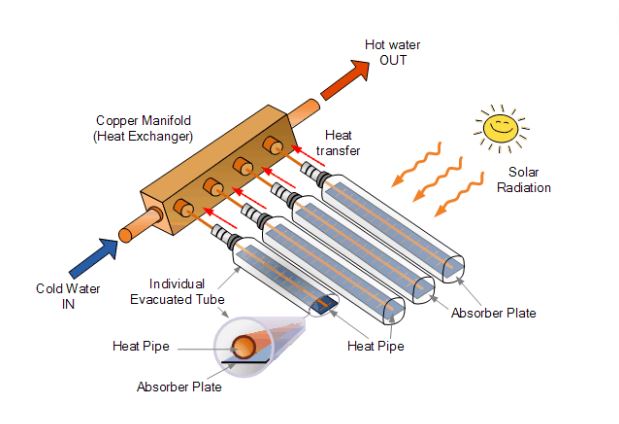
How Heat Pipe Collector Works
The functioning of heat pipe solar collectors is based on a set of principles such as the phase change principle. These principles ensure that the collectors function effectively and efficiently right from absorption to conversion of solar energy into heat energy.
Solar Radiation Absorption:
Upon striking of sunlight to the vacuum tubes, absorption of solar rays occurs and thereafter the rays are converted into thermal energy.
Evaporation:
The heat absorbed results in the evaporation of the fluid in the heat pipes. Afterward, the evaporator section allows for vaporization to take place, and for this process to efficiently occur, there is a need for a low-temperature environment in the heat pipes.
Condensation:
The condenser section which forms the area around the top of the heat pipe is responsible for cooling the vapor. Moreover, this section is connected to the manifold that acts as a point of heat collection from various heat pipes.
Heat Transfer Medium:
This can entail a medium such as air or water through which heat is absorbed from the condenser.
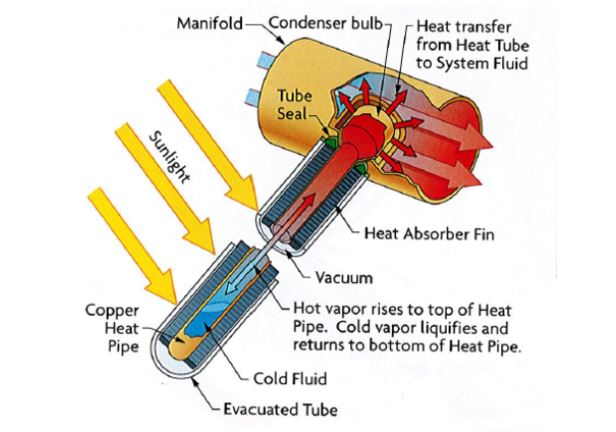
Common Problems with Heat Pipe Solar Collectors
Overheating Problem
They are prone to overheating especially during hot weather conditions or exposure of the system to strong solar radiation. As a result, the performance of the system is reduced due to the excessive boiling of the fluid.
Freezing Problem
During cold weather conditions, the fluid may tend to freeze inside the heat pipes thus damaging the whole system. To curb this, anti-freezing solutions with relatively low freezing points can be used instead.
Possible Leaks Problem
Possible leaks may occur over time especially when the system is not properly checked and maintained. This can also be caused by possible physical damages, manufacturing defects, or wearing out of material.
Rust and Corrosion
Even though these collectors are made from materials such as aluminum or copper that are poised to be resistant to corrosion, high chemical exposure, and humidity can result in corrosion over a given period.
Improving Heat Pipe Collector Efficiency
- High-efficiency selective absorber coating: The use of a high-efficiency selective absorber coating will ensure a high rate of sunlight absorption.
- Insulation: The system needs to be effectively insulated especially the heat pipes to reduce and minimize the amount of heat loss.
- Maintenance: Constant checking and maintenance of the device is required to improve its durability.This can entail removal of dirt and dust that can reduce the performance of the system.
Factors Determining Heat Pipe Solar Collector Price
Below are some of these factors;
Heat Pipe Solar Collector Manufacturer
The price of heat pipe solar collectors may vary depending on the brand and manufacturer that produces them. In this case, well-established brands are likely to attract a higher price as opposed to brands that are not well-known to people.
Size of Solar Collector
Different sizes of collectors come with different prices. The price of collectors, therefore, tends to increase with the increase in the collector’s size.
Quality Grade of Solar Collector
The quality of collectors is determined by the type of materials used in their construction. Collectors of high quality will attract higher prices as compared to those of low quality.
Heat Pipe Thermal Collector Applications
Water Heating Systems
This is because they have efficient absorption of sunlight and effective transfer of solar energy to transfer fluid.
Solar Power Generation
This method can be incorporated in plants that generate solar power since the heat pipes absorb energy, and transfer the heat energy to the fluid which in turn rotates the turbines to produce electric power.
Industrial Processes
The method can be applied in various industrial processes that require high temperatures such as textile manufacturing, food processing, and chemical production.
Room Heating
They can be applied in solar air heating in that they absorb solar energy and channel it afterward to the air. This can be used in buildings for space heating.
Conclusion
In summary, heat pipe solar collectors have attracted a wide range of users due to the many advantages they offer over other types of solar collectors. For instance, they are efficient to use, durable as well as have reduced heat loss. Likewise, they also have a wide range of applications such as industrial use, water and room heating among others.




